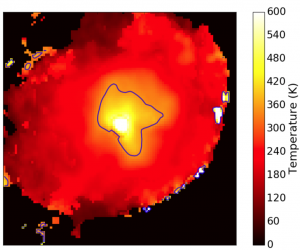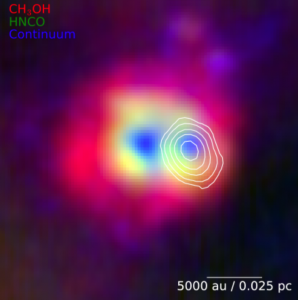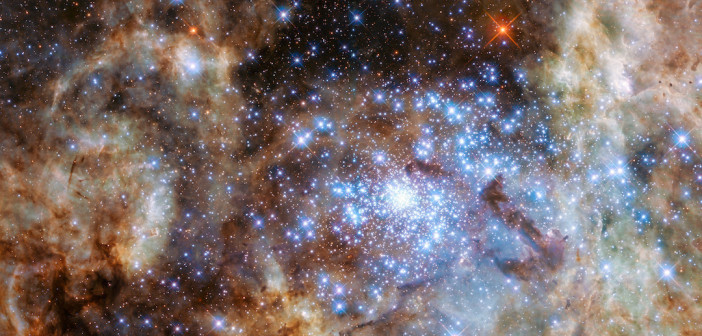Editor’s note: Astrobites is a graduate-student-run organization that digests astrophysical literature for undergraduate students. As part of the partnership between the AAS and astrobites, we repost astrobites content here at AAS Nova once a week. We hope you enjoy this post from astrobites; the original can be viewed at astrobites.org!
Title: Thermal Feedback in the High-mass Star and Cluster Forming Region W51
Authors: Adam Ginsburg, Ciriaco Goddi, J.M. Diederik Kruijssen, et al.
First Author’s Institution: National Radio Astronomy Observatory
Status: Accepted to ApJ, open access
Today let’s talk about massive stars! My favorite view of massive stars is the Hubble image of the star cluster R136 in the Large Magellanic Cloud, shown in cropped form in the cover photo above. All the blue shining spots in this picture are massive stars, with masses up to hundreds of solar masses that are million times brighter than the Sun! Massive stars bring beauty to our night skies, as well as structure to the universe. The Hubble image shows massive stars in their magnificent adulthood. But have you ever wondered what they looked like when they were still babies?

Figure 1. W51 as seen by the radio observatories ALMA and VLA. Images from radio observations are ‘false color’, meaning that the colors represent light that cannot be seen with naked eyes. Color scheme: blue is the carbon monoxide (CO) line, orange is the methanol (CH3OH) line, purple is the cyanoacetylene (HC3N) line, green is the radio continuum, and the white haze is free-free emission of ionized gas. [Ginsburg et al. 2017]
The paper looks at three baby massive stars in W51: e2, e8, and North (Figure 1). These objects were chosen because of their strong star formation and the gas clouds have not been destroyed by supernova explosions, which are the key ingredients for understanding high-mass star formation. While the authors uncovered a wealth of information through their observations in the paper, here we focus on two main aspects: the temperature and ionization structures around the baby massive stars.

Figure 2. Temperature map around the hot core e2. This map was created using the molecular emission lines of methanol around the source. We see that the baby high-mass star heats up a large volume with a radius about 5,000 AU. [Ginsburg et al. 2017]

Figure 3. Image showing the highly excited warm molecular gas (colors) and the free-free radio emission from ionized gas (contours) around e2. The legend shows the nature of different colors. The absence of enhanced heating around the ionized region suggests that ionizing radiation has little effect on the dense molecular gas. [Ginsburg et al. 2017]
- There is no enhanced heating of dense gas (brighter colors) around the ionized region (contours). The authors conclude that ionizing radiation from already-formed massive stars has little effect on the star-forming gas;
- The bright dust continuum emission (left blue blob) predicts strong ionizing radiation from the embedded baby stars, but the corresponding free-free emission (white contours) is not observed. The authors proposed an explanation: rapid accretion onto the growing stars bloats them and reduces their surface temperature, making them too cold to emit ionizing radiation. This is a big deal! The working of simultaneous gas infall and outward radiation feedback is extremely hard to model even with simulations and supercomputers. Today’s paper presents the first observational insight on what actually happens to growing massive stars!
Today’s paper is a pedagogical piece showcasing how bright scientists and next-generation observatories translate into new insights for future observations and simulations. These insights are necessary for us to understand how beautiful massive clusters like R136 came to be. Indeed, we expect the active star formation in the early universe behaved similarly to within forming massive clusters. Understanding how massive star clusters form therefore provides a unique basis to connect the cosmic history of star formation.
P.S. The first author of today’s paper is also an active developer of astronomy software — check out his Github page!
About the author, Benny Tsang:
I am a graduate student at the University of Texas at Austin working with Prof. Milos Milosavljevic. Using Texas-sized supercomputers and computer simulations, I focus on understanding the effects of radiation from stars when massive star clusters are being assembled. When I am not staring at computer screens, you will find me running around Austin, exploring this beautiful city.

1 Comment
Pingback: birthplaces of massive stars